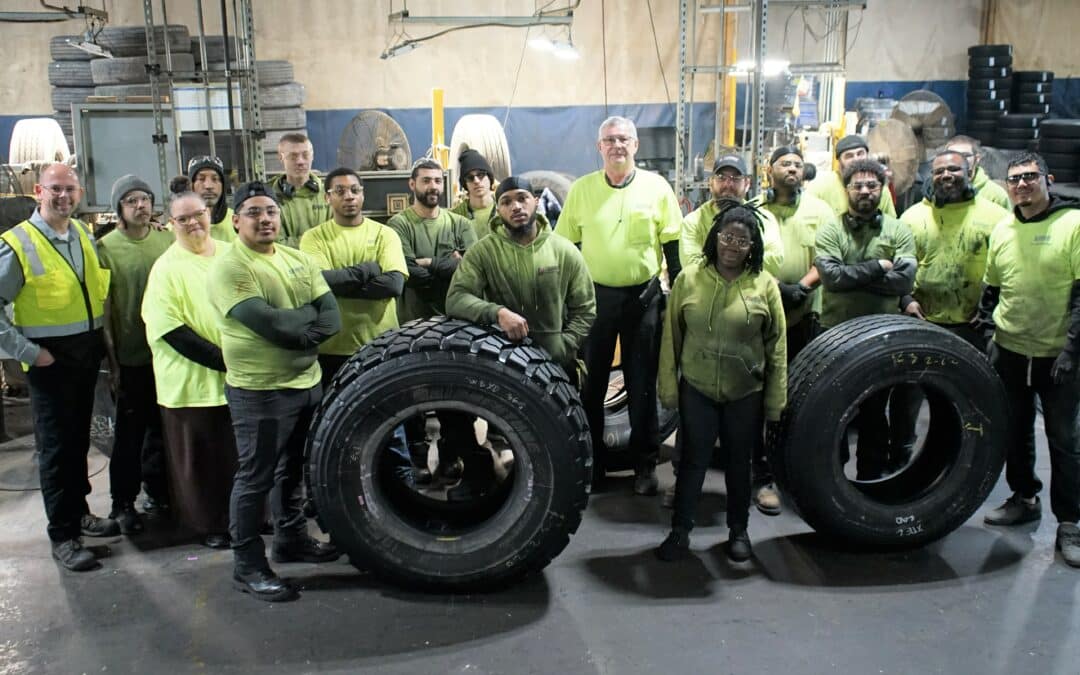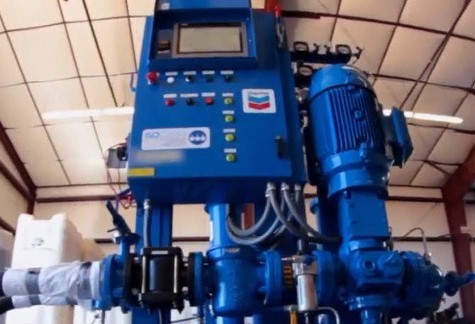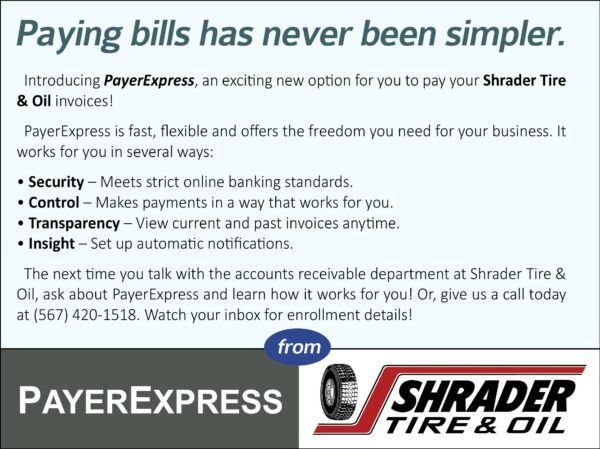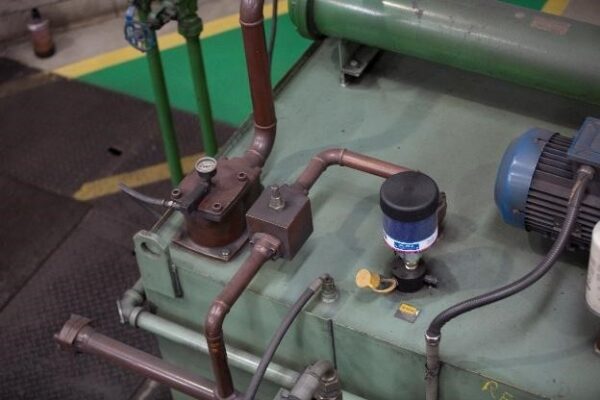×

×
Don't Miss Upcoming Promotions
Enter your email below to stay updated on our latest specials.

As a certified Michelin Retreader, Shrader Tire & Oil recently earned the highest audit scores in the industry.
With our nine-step manufacturing process, we ensure efficient and quality results. Our retreads are held to the highest standard and are inspected thoroughly – both digitally and by hand. To support our claims, all of our retreads are backed by a warranty.
Shrader Tire and Oil was a big winner at a recent Michelin awards banquet, winning multiple awards after the annual audit.
“STO made an extremely big splash,” said General Manager of Manufacturing and MDC Distribution Bob Watters. “By earning such high scores, both of the Shrader Tire and Oil plants exhibited our commitment to continuous improvement.”
MRT I, located in Melvindale, Mich., received a 100 percent Audit Safety Score. MRT II, located in Pemberville, Ohio, received a quality audit score of 98 percent.
Here’s a breakdown of the awards:
MELVINDALE BEST OF BEST ACHIEVEMENT AWARDS:
PEMBERVILLE BEST OF BEST ACHIEVEMENT AWARDS:
Contact Shrader Tire & Oil today at 800-859-6589 and ask about our retreads. You will be glad you did!

By Zach Sutton | Chevron Lubricants
March 8, 2023 – December roared in with a coast-to-coast series of howling snowstorms and plunging temperatures. It’s the time of year when fleet operators and drivers become more conscious of the coolants they are using and making sure they are working properly. In reality, thinking of coolant maintenance as a seasonal issue is a bit old fashioned. At Chevron Lubricants, we advocate year-round coolant inspections as part of your preventive maintenance program. In fact, we recommend to our fleet customers that they include a cooling system checklist in their PM worksheets. The importance of a healthy coolant should not be underestimated – 40% of engine-related failures are tied to the coolant, and an “estimated 60% of engine downtime in the commercial trucking sector is coolant related.”* It cannot be an afterthought.
The only opportunity maintenance managers have to make sure a truck has the right amount of coolant, and its physical properties are in proper balance, is when the truck is in the bay for regular maintenance. If a driver has to top off the reservoir on the road, he or she runs the risk of co-mingling two incompatible coolants. The coolant should be tested before a vehicle is put back into service to make sure it’s good to go.
Testing a coolant starts with a visual inspection – look to make sure it’s clear, bright, and free of any particles. Next, check the freeze point using a properly calibrated refractometer. The freeze point – the temperature at which the coolant will freeze – is the fluid’s most important physical property. A refractometer will show the balance of glycol to water in the coolant, which is what determines the freeze point. We have found that the floating ball hydrometers commonly used in the industry are inconsistent, inaccurate and ineffective; therefore, we do not recommend its use. Most test labs use refractometers and they are fairly easy for maintenance crews to utilize.
The next step is to test for the acidity, or alkalinity, level of the coolant. This is done using a pH test strip, which ranges from zero to 14. In an extended-life coolant, the pH level should be around eight or nine. If it drops below that, it means the coolant is turning acidic and you have to track down the cause of the acidity. If you are using a nitrite-free coolant and the pH level is higher than nine, it is likely an indicator that you may have nitrites in the coolant that are interacting with unpassivated aluminum in the system or with the flux used to join those aluminum parts together.
The aftermarket is filled with high- and low-quality coolants of all colors; therefore, color is not a good indicator of the type of coolant* and operators should not rely on the coolant color to determine the extent of a coolant’s properties or performance. In fact, the color is merely a dye and has nothing to do with coolant performance. It is imperative to read the fine print on the coolant label to ensure you are maintaining the appropriate coolant type in your system. Make sure the test strip is of the color-resistant variety; sometimes the dye in a coolant can interfere with the reading.
Finally, don’t overlook the radiator cap. Make sure it is not broken or cracked and is sealing correctly, and the system is properly pressurized. If it’s not, the water can boil off, resulting in an excessive concentration of glycol, which can lead to extensive issues, the most common of which is damage to the exhaust gas recirculation (EGR) system. Check the cap frequently – caps are inexpensive and have been known to fail right out of the box.
As part of incorporating coolant maintenance into your preventative maintenance schedule, a full coolant analysis performed at an analytical laboratory should be performed once a year. This analysis is vital to provide an insight into the overall operating condition of the in-service coolant.
Adding coolant maintenance to your existing program will help reduce downtime and increase efficiency. With the additional coolant testing being performed, don’t forget to consistently log the results to track the trends over time. This is a good practice, not only with coolant maintenance, but also with your other fluids.
Clearly there is more to coolant maintenance than simply topping of the reservoir at a truck stop. It should be part of every regular maintenance interval. The same procedures hold true for both on- and off-highway heavy duty equipment. If you are performing regular coolant testing all year round, you don’t need to worry about “winterizing” your cooling system. However, if the onset of winter elevates coolants to top of mind, then there is no time like the present to do a proper inspection. If you discover problems with the coolant, it is advisable to flush it out completely and start fresh with clean and reliable coolant.

We are excited to introduce a redesigned, updated ISOCLEAN® Recommended ISO 4406 Specs quick links sheet for ISOCLEAN customers.
The one-page link sheet is easy to use and a gear oils spec sheet has been added. The category spec sheets are organized by industry and by component.
As equipment continues to evolve and customers become more aware of the effects contaminants are having on their equipment, it will be important for them to have this capability and evolve their business. Particle contamination is the No. 1 cause of lubricant related failure in equipment. It makes sense to solve this problem, starting with Chevron ISOCLEAN Certified Lubricants is the first step to maximizing equipment life.
The Chevron ISOCLEAN Certified Lubricants program is the industry-leading solution for customers to meet their equipment manufacture fluid cleanliness.
Get to the next level and be on the leading edge with Chevron ISOCLEAN Certified Lubricants!



This year’s focus for Operation Safe Driver Week is speeding.
Safe Driver Week began Sunday, July 10, across the United States, Canada, and Mexico. Law enforcement will be on roadways throughout this week watching for commercial motor vehicle and passenger vehicle drivers engaging in unsafe driving behaviors, such as speeding, distracted driving, following too closely, improper lane change, drunk or drugged driving, etc.
At Shrader Tire and Oil, safety is always our No. 1 priority, whether its delivering products to one of our 14 fleet stores to getting your fleet back in service.

The Commercial Vehicle Safety Alliance’s (CVSA) Operation Safe Driver Program was created to improve the driving behaviors of all drivers and reduce the number of crashes involving commercial motor vehicles on our roadways through educational and traffic enforcement strategies. Operation Safe Driver Week was created by CVSA with support from federal agencies in Canada, Mexico and the U.S., the motor carrier industry, and transportation safety organizations.
This year’s campaign encourages everyone to slow down and travel at a safe speed.
“This safe driving initiative and campaign focuses specifically on drivers’ actions – whether it’s something a driver did, like speeding, or something they didn’t do, such as not paying attention to the driving task,” said CVSA President Capt. John Broers with the South Dakota Highway Patrol. “This focus on drivers’ behaviors is our effort to identify and educate drivers who are operating dangerously on our roadways, with the goal of preventing crashes from occurring.”

Earlier this year, the U.S. Department of Transportation’s National Highway Traffic Safety Administration (NHSTA) released its latest annual traffic crash report, showing that 38,824 lives were lost in traffic crashes nationwide in 2020 – the highest number of fatalities since 2007. And while the number of crashes and traffic injuries declined overall, fatal crashes increased by 6.8%.
Among the alarming statistics in NHTSA’s report was the key finding that speed-related fatalities increased by 17%. Consequently, speeding, in particular, will be a dangerous driving behavior that officers will identify and target during Operation Safe Driver Week.
“The rising fatalities on our roadways are a national crisis; we cannot and must not accept these deaths as inevitable,” said U.S. Transportation Secretary Pete Buttigieg.
Shrader Tire & Oil is committed to safety and welcomes the special focus this year on Safe Driver Week.

By Mark Barnes, Chevronlubricants.com
(June 20, 2022) — Are you losing the battle on extending equipment life? Are you changing your oil too often or having machine failures? Most companies are now realizing that maintaining clean oil is one of the best investments they can make, with contamination at the core of premature machinery failure and diminished lubricant life. However, many companies do not know where to start in preventing contamination or how to build the business case to get budgetary approval.Purchasing clean oil, such as ISOCLEAN® lubricant, is a great start. Equally important is keeping the oil clean while in use, since contamination often remains an overlooked factor behind premature machinery failure and diminished lubricant life. The ever-increasing cost of oil brings a heightened awareness of the need to minimize usage and waste, as well as a desire to prolong equipment life, making the economic case for protecting oil from contamination — from the time oil enters a facility until it leaves.
The two primary types of contamination are dirt and water. It stands to reason that if the atmosphere is contaminated (and most are to some degree), the oil is probably dirty, and lubricant quality is compromised. Unless you are using ISOCLEAN oils, most lubricants aren’t delivered clean. Particulate contamination, once inside an operating system, will accelerate the generation of new contaminants through abrasive and erosive wear. These contaminants damage critical components and act as a catalyst for oxidation, further degrading lubricant health.
If the atmosphere is particularly humid or has frequent temperature fluctuations, the oil is probably moisture-laden and lubricant quality is compromised. Oftentimes, plant wash down activities are responsible for inducing conditions that lead to moisture ingression and corrosion.
The good news is that these factors, which work together to threaten equipment reliability, can be effectively controlled with some preventative maintenance techniques. The best and easiest way to exclude contaminants is to start with clean oil by using ISOCLEAN oils and to keep the oil clean by deploying effective strategies to exclude and remove contaminants at the source.
A multi-faceted program that includes some simple proactive steps will conquer contamination. Oftentimes, starting a lubrication best practices program can feel overwhelming and stressful, but by using the right steps and the right support, the journey from poor lubrication to preferred practices can become a successful venture. Without careful planning, it can become an exercise in futility where nothing ever gets done, and nothing ever changes. So how do you make sure your lubrication journey is successful and not a failure?
Figure 1: Three steps to effective contamination control

Today, there’s tons of information found online, at training classes and workshops, as well as at conferences. But how do you sift through this plethora of information and make the right choices for your lubrication program? Before a lubrication best practices program can be created it is important to consider the industry and your applications. Every industry and every application are unique, and what’s right for someone in one environment isn’t what’s needed for someone else with a more critical application or different type of equipment with finer tolerances or a plant with different production schedules.
The path you take to reach your destination will depend on your circumstances, budget, and goals. You know where you’re starting from and you know the end goal: get the right amount of oil or grease in each machine, while ensuring that the lubricant is kept clean, dry, and cool. It’s pretty simple. But how do you get there? Maybe you handle oil in barrels, which means a small portable filter unit capable of mounting on top of the barrel is the best route. For smaller volume transfers, a sealed oil transfer container keeps oil clean while in storage and in use throughout the plant. In addition, a desiccant breather keeps the lubricant clean and dry while in use. It is a matter of selecting the best route to lead you to your goal.
Figure 2: A desiccant breather protecting the equipment from particle and moisture contamination.

Now you must decide who is actually going to do the lubrication. Do you prefer to have dedicated lubrication techs, general mechanics who also do lubrication, or is your goal to have operators do basic tasks? Each option has pros and cons but this decision is a major “fork in the road” that dictates other decisions down the road.
Once you have chosen the general direction, the choices become even more granular. After you make the “big picture” decisions (bulk vs. barrel, supplier A vs. supplier B, lube tech vs. operator), there’s a host of choices still to be made. For example, electric motor lubrication. Do you want to use a simple route-base process, which includes calculating the optimum volume and frequency to re-grease, or do you want to invest in an ultrasonic tool to make the process more rigorous? Both will give you good reliability if you apply the process correctly.
The decisions are endless: Which color should I color code gear oil? What tests should I do for hydraulic fluids? How should I monitor oil level in my process pumps? Will the electricians be responsible for motor lubrication?
The key is you have a path laid out and start to plan the options and preferences ahead of time to avoid going off course. Starting out with a goal to “improve our lubrication program” is not a plan – it’s a desire. Instead, each decision point should be mapped so options can be considered, and the right decisions made based on a combination of company goals, plant layout and operating environment.
The need for someone to “own” the plan is equally important. All successful lubrication improvements have a champion – the “voice of reason” – to coach and help steer the team into making the right decisions.
However, even the best laid lubrication plans often encounter unexpected issues, some harder to negate than others. The benefit of regularly scheduled oil samples warns of impending problems and drives continuous improvement. This can be the difference between a minor speed bump and a total and catastrophic breakdown.
Simple visual inspections can go a long way toward identifying problems before they become problematic. Using an oil level indicator to check oil levels and inspecting the color and clarity of the oil with a sight glass or bottom sediment bowl are great ways to identify potential issues. Other activities such as recording bearing temperatures with a non-contact infra-red pyrometer, looking at the color of the breather and direction of color change can all pinpoint emergent issues. A basic lubrication check sheet like those used by pilots for pre-flight checks are a good idea to make sure everyone is inspecting the lubricants and expecting the same results.
Figure 3: Replacing a flat sight glass with a 3D sight glass is a simple inexpensive modification that can greatly enhance the reliability of oil level checks.

Not every asset or equipment type is the same and thus, your lubrication best practice program will need to account for that. For example, set tighter limits on contaminants and other oil condition parameters to ensure production or safety on critical assets are kept under strict control. Also, an ISO cleanliness code of 19/17/14 and 500 ppm of water might be acceptable for a large, slow-turning gearbox. However, a more critical high-pressure hydraulic system with servo valves will need a much lower ISO code of 15/13/10 or better and no more than 100 ppm of water. Whenever you exceed those limits, you should be checking the breather and other points of ingression or employing supplemental filtration, until oil analysis tells you oil cleanliness is back in compliance.
Precision lubrication is not a destination, it is a journey. If we’re always looking for an end point where we intend to stop, complacency often sets in, and we slip back into bad habits. Like other reliability initiatives, precision lubrication is about creating a new culture where continuous improvement is built into everyday discussions.
There should be attention and planning about what kind of lubricants we select, how they will be stored, and how they will get from storage to the machine. From cradle to grave, lubricants will be exposed to contaminants, which must be addressed at source to ensure the oil arrives at its final destination, clean and contamination free.
Equipment life can be greatly extended through proper lubrication management, which effectively starts with breather protection, offline filtration, and oil sampling. In today’s competitive market, most companies are now realizing that maintaining clean oil is one of the best investments they can make to reduce premature machinery failure.
By utilizing options outlined above and implementing several contamination control techniques as best practices, maintaining clean, dry lubricants — and gaining the profitability that goes along with it — is easier than ever.
Shrader Tire and Oil proudly carries the Chevron line of heavy-duty and industrial lubricants. Recognized by Chevron as a 1st Source Elite Chevron Lubrication Marketer, Shrader Tire & Oil has attained the highest ranks of performance and customer satisfaction and is committed to the long-term success of your business.